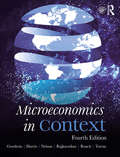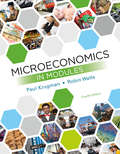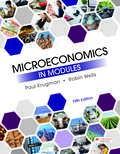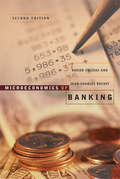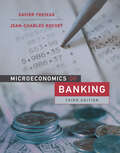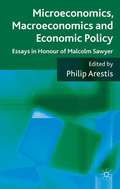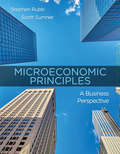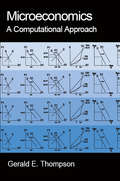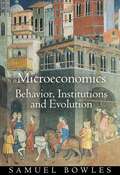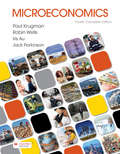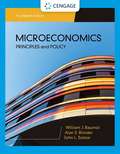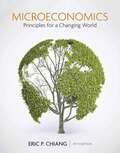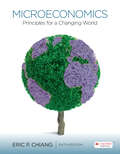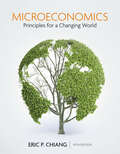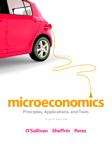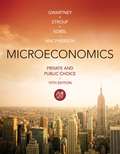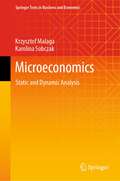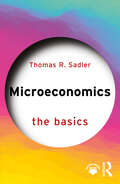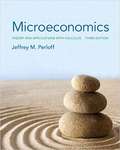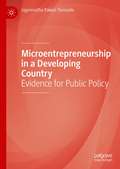- Table View
- List View
Microeconomics in Context: Preliminary Edition
by Neva Goodwin Jonathan M. Harris Julie A. Nelson Brian Roach Mariano TorrasMicroeconomics in Context lays out the principles of microeconomics in a manner that is thorough, up to date, and relevant to students. Like its counterpart, Macroeconomics in Context, the book is uniquely attuned to economic realities. The "in Context" books offer affordability, accessible presentation, and engaging coverage of current policy issues from economic inequality and global climate change to taxes.Key features include: --Clear explanation of basic concepts and analytical tools, with advanced models presented in optional chapter appendices;--Presentation of policy issues in historical, institutional, social, political, and ethical context--an approach that fosters critical evaluation of the standard microeconomic models, such as welfare analysis, labor markets, and market competition;--A powerful graphical presentation of various measures of well-being in the United States, from income inequality and educational attainment to home prices; --Broad definition of well-being using both traditional economic metrics and factors such as environmental quality, health, equity, and political inclusion; --New chapters on the economics of the environment, taxes and tax policy, common property and public goods, and welfare analysis; --Expanded coverage of high-interest topics such as behavioral economics, labor markets, and healthcare; --Full complement of instructor and student support materials online, including test banks and grading through Canvas.
Microeconomics in Context: Preliminary Edition
by Neva Goodwin Jonathan M. Harris Julie A. Nelson Brian Roach Mariano Torras Pratistha Joshi RajkarnikarMicroeconomics in Context lays out the principles of microeconomics in a manner that is thorough, up to date, and relevant to students. Like its counterpart, Macroeconomics in Context, the book is uniquely attuned to economic, social, and environmental realities. The "In Context" books offer affordability, accessible presentation, and engaging coverage of current policy issues from economic inequality and global climate change to taxes and globalization. Key features include: Clear explanations of basic concepts and analytical tools, with advanced models presented in optional chapter appendices; Presentation of policy issues in historical, environmental, institutional, social, political, and ethical contexts—an approach that fosters critical evaluation of the standard microeconomic models, such as welfare analysis, labor markets, and market competition; A powerful graphical presentation of various measures of well-being in the United States and other countries, including income inequality, taxes, educational attainment, and environmental quality; Broad definitions of well-being using both traditional economic metrics and factors such as environmental quality, health, equity, and political inclusion; Significantly revised chapters on globalization and trade, economic and social inequality, labor markets, and public goods; Expanded coverage of high-interest topics such as behavioral economics, labor markets, and economic discrimination; Full complement of instructor and student support materials online. This new edition also features more international data and analysis, and further material on the importance of economic power in shaping policy. The latest addition to the "In Context" series combines real-world relevance with a thorough grounding in multiple economic paradigms.
Microeconomics in Modules
by Paul Krugman Robin WellsWhen it comes to explaining fundamental economic principles by drawing on current economic issues and events, there are no authors more effective than Nobel laureate and New York Times columnist Paul Krugman and co-author, Robin Wells. Here, Krugman and Wells’ signature storytelling style and uncanny eye for revealing examples come together in an accessible, modular format to help readers understand how economic concepts play out in our world. Instead of having chapters of traditional length, this version covers the core concepts of economics in a series of brief modules, each focused on one topic and designed to assigned in any order and read comfortably in one sitting. This new edition is more accessible than ever and includes SaplingPlus, a complete, integrated online learning system that supports students and instructors at every stage of learning—pre-class, in-class, and post-class.
Microeconomics in Modules
by Paul Krugman Robin WellsWhen it comes to explaining fundamental economic principles by drawing on current economic issues and events, no one is more effective than Nobel laureate and New York Times columnist Paul Krugman and co-author, Robin Wells. In this modular text, Krugman and Wells’ signature storytelling style helps readers understand economic concepts in the real world. Instead of long, traditional chapters of traditional length, this version presents brief modules, each focused on one topic and easy to read in one sitting.
Microeconomics of Banking
by Jean-Charles Rochet Xavier FreixasThe second edition of an essential text on the microeconomic foundations of banking surveys the latest research in banking theory, with new material that covers recent developments in the field. Over the last thirty years, a new paradigm in banking theory has overturned economists' traditional vision of the banking sector. The asymmetric information model, extremely powerful in many areas of economic theory, has proven useful in banking theory both for explaining the role of banks in the economy and for pointing out structural weaknesses in the banking sector that may justify government intervention. In the past, banking courses in most doctoral programs in economics, business, or finance focused either on management or monetary issues and their macroeconomic consequences; a microeconomic theory of banking did not exist because the Arrow-Debreu general equilibrium model of complete contingent markets (the standard reference at the time) was unable to explain the role of banks in the economy. This text provides students with a guide to the microeconomic theory of banking that has emerged since then, examining the main issues and offering the necessary tools for understanding how they have been modeled. This second edition covers the recent dramatic developments in academic research on the microeconomics of banking, with a focus on four important topics: the theory of two-sided markets and its implications for the payment card industry; “non-price competition” and its effect on the competition-stability tradeoff and the entry of new banks; the transmission of monetary policy and the effect on the functioning of the credit market of capital requirements for banks; and the theoretical foundations of banking regulation, which have been clarified, although recent developments in risk modeling have not yet led to a significant parallel development of economic modeling.
Microeconomics of Banking, third edition
by Jean-Charles Rochet Xavier FreixasThe third edition of a leading text on the microeconomic foundations of banking, comprehensively updated with new coverage of the 2008 Global Financial Crisis, fintech, and the latest research in banking theory.The banking industry has undergone seismic change in the twenty-first century, from the overhaul of regulation in the wake of the 2008 Global Financial Crisis to the digitalization of the economy and the disruption of traditional business models by ascendant tech giants. Now in a comprehensively updated third edition, this essential graduate-level text on the microeconomic foundations of banking provides the rigorous theoretical approach required to understand these new structures and norms, functioning as a user&’s guide to recent academic literature. Microeconomics of Banking offers a comprehensive view of the evolution of banking theory and the rapidly changing realm of financial intermediation, examining the central issues and offering the necessary tools for understanding how they have been modeled. New edition highlights:Up-to-date coverage of the latest research in banking theory as well as the events of the global financial crisis and resultant Basel III regulatory frameworkNew chapters on liquidity and systemic riskNew material throughout on cryptocurrencies, fintech, and other facets of a digitalized economy
Microeconomics using Excel: Integrating Economic Theory, Policy Analysis and Spreadsheet Modelling
by Gerald Schwarz Kurt Jechlitschka Dieter KirschkeUsing Microsoft Excel, the market leading spreadsheet package, this book combines theory with modelling aspects and spreadsheet analysis. Microeconomics Using Excel provides students with the tools with which to better understand microeconomic analysis.It focuses on solving microeconomic problems by integrating economic theory, policy analysis and
Microeconomics, Macroeconomics and Economic Policy
by Philip ArestisMicroeconomics, Macroeconomics and Economic Policy are at the core of research and study in economics. The essays in this volume have been specifically commissioned and brought together to celebrate the work of Malcolm Sawyer, who has made substantial contributions in these areas.
Microeconomics: A Business Perspective
by Rubb SumnerCreated specifically for the economics course as taught in business schools, Economic Principles: A Business Perspective covers the fundamentals of economics in the context of today's globalized business world, with strong examples, integrated technology, and practical pedagogy. Integrated business and policy briefs, in-depth case studies, chapter-ending business applications, thoroughly explained graphs and a battery of simple but useful learning tools support the intersection of theory and practice. It's accompanied by a robust media component, SaplingPlus, which combines Sapling's acclaimed online homework with a complete e-book and all interactive features for the text.
Microeconomics: A Computational Approach
by Gerald E. ThompsonThis concise and comprehensive introduction to economics offers readers at all levels a more realistic approach to understanding the elements of resource and product markets, including the role of business decisions; technological change; product differentiation; uncertainty; and the optimal location of activities. With the book's easy-to-use software package for computations, even non-economists will become strongly motivated and can gain a proficiency in economic analysis as well as in practical and professional decision-making skills. End-of-chapter problems, computer exercises, programming examples, and numerous diagrams further enhance the book's usefulness.
Microeconomics: A Global Text
by Judy WhiteheadMicroeconomics is concerned with the production, consumption and distribution of goods by the micro units of individuals, firms and markets within the economy. It can also be considered a study of scarcity and the choices to be made for the attainment of goals within constraints. These goals are those set by consumers, producers and policy makers in the market. This book provides a brand new approach to the teaching and study of microeconomics – an elementary guide to the fundamental principles of the subject. It gives students from all parts of the world the opportunity to understand and appreciate the value of microeconomic tools and concepts for analyzing market processes in their economic environment, as well as maintaining a perspective on issues of trade and competitiveness, thus drawing attention to the relevance of microeconomic theory beyond the domestic scene to issues of trade and competitiveness on the international arena. The book contains a wealth of international case studies and covers topics such as: - elasticity - Cobb-Douglas Production functions - dynamic stability of market equilibrium - monopolies and monopolistic competition - project analysis The perfect introduction to the building blocks of contemporary microeconomic theory, this book will be of interest to undergraduate students in international economics, industrial economics, managerial economics and agricultural economics. It will also be a useful reference guide for graduates requiring a break down of difficult microeconomic principles.
Microeconomics: Behavior, Institutions, and Evolution ((The Roundtable Series in Behavioral Economics)
by Samuel BowlesIn this novel introduction to modern microeconomic theory, Samuel Bowles returns to the classical economists' interest in the wealth and poverty of nations and people, the workings of the institutions of capitalist economies, and the coevolution of individual preferences and the structures of markets, firms, and other institutions. Using recent advances in evolutionary game theory, contract theory, behavioral experiments, and the modeling of dynamic processes, he develops a theory of how economic institutions shape individual behavior, and how institutions evolve due to individual actions, technological change, and chance events. Topics addressed include institutional innovation, social preferences, nonmarket social interactions, social capital, equilibrium unemployment, credit constraints, economic power, generalized increasing returns, disequilibrium outcomes, and path dependency. Each chapter is introduced by empirical puzzles or historical episodes illuminated by the modeling that follows, and the book closes with sets of problems to be solved by readers seeking to improve their mathematical modeling skills. Complementing standard mathematical analysis are agent-based computer simulations of complex evolving systems that are available online so that readers can experiment with the models. Bowles concludes with the time-honored challenge of "getting the rules right," providing an evaluation of markets, states, and communities as contrasting and yet sometimes synergistic structures of governance. Must reading for students and scholars not only in economics but across the behavioral sciences, this engagingly written and compelling exposition of the new microeconomics moves the field beyond the conventional models of prices and markets toward a more accurate and policy-relevant portrayal of human social behavior.
Microeconomics: Canadian Edition
by Paul Krugman Robin Wells Iris Au Jack ParkinsonWhen it comes to explaining fundamental economic principles by drawing on current economic issues and events, there is no one more effective than Nobel laureate and New York Times columnist Paul Krugman and co-authors, Robin Wells, Iris Au, and Jack Parkinson. In this best-selling introductory textbook, the authors’ signature storytelling style and uncanny eye for revealing examples help readers understand how economic concepts play out in our world. Canadian co-authors Jack Parkinson and Iris Au have enhanced the text with current Canadian examples.
Microeconomics: Principles and Policy (MindTap Course List)
by Alan Blinder William Baumol John SolowMaster today's principles of microeconomics and gain an understanding of current economic issues and their importance as Baumol/Blinder/Solow's MICROECONOMICS: PRINCIPLES AND POLICY, 14E provides a solid introduction to microeconomics using policy-based examples and applications. Written by several of today's most respected economists, this book is one of the most up-to-date microeconomics choices on the market -- incorporating data and issues as recent as 2018. The authors combine the right level of rigor and detail to clarify even the most complicated microeconomics concepts. An entirely new chapter closes the book by delving into some of the most important issues confronting the U.S. economy today. Throughout this edition, well-developed examples, intriguing puzzles and meaningful microeconomics issues provide an excellent balance of theory to application while keeping you engaged and intrigued.
Microeconomics: Principles for a Changing World
by Eric ChiangWith this edition, Eric Chiang continues to link economics concepts to topics of personal interest to students. The new edition is a thoroughly contemporary, fully integrated print/technology resource that adapts to the way you want to teach. As always, this concise book focuses on the topics most often covered in the principles course, but with this edition, it offers a stronger emphasis than ever on helping students apply an economic way of thinking to the overwhelming flow of data we face every day. <p><p>Economics: Principles for a Changing World is fully informed by Eric Chiang’s experiences teaching thousands of students worldwide, both in person and online. Developing the text, art, media, homework, and ancillaries simultaneously, Chiang translates those experiences into a cohesive approach that embodies the book’s founding principles:
Microeconomics: Principles for a Changing World
by Eric ChiangChiang makes fundamental economic ideas clear and relevant to the diverse range of students who take the principles course.
Microeconomics: Principles for a Changing World
by Eric ChiangWith this edition, Eric Chiang continues to link economics concepts to topics of personal interest to students. The new edition is a thoroughly contemporary, fully integrated print/technology resource that adapts to the way you want to teach. As always, this concise book focuses on the topics most often covered in the principles course, but with this edition, it offers a stronger emphasis than ever on helping students apply an economic way of thinking to the overwhelming flow of data we face every day. Economics: Principles for a Changing World is fully informed by Eric Chiang’s experiences teaching thousands of students worldwide, both in person and online. Developing the text, art, media, homework, and ancillaries simultaneously, Chiang translates those experiences into a cohesive approach that embodies the book’s founding principles: To use technology as a tool for learning—before lectures, during class, when doing homework, and at exam time To help students harness the data literacy they’ll need as consumers of economic information
Microeconomics: Principles, Applications, and Tools (Eighth Edition)
by Arthur O'Sullivan Steven M. Sheffrin Stephen J. PerezFor Principles of Microeconomics courses. Microeconomics: Principles, Applications, and Tools, is also suitable for economists, financial analysts and other finance professionals. Questions that drive interest, applications that illustrate concepts, and the tools to test and solidify comprehension. Students come into their first Economics course thinking they will gain a better understanding of the economy around them. Unfortunately, they often leave with many unanswered questions. To ensure students actively internalize economics, O'Sullivan/Sheffrin/Perez use chapter-opening questions to spark interest on important economic concepts, applications that vividly illustrate those concepts, and chapter-ending tools that test and solidify understanding.
Microeconomics: Private and Public Choice (Fifteenth Edition)
by James D. Gwartney David A. Macpherson Russell S. Sobel Richard L. StroupMICROECONOMICS: PRIVATE AND PUBLIC CHOICE, Fifteenth Edition, reflects current economic conditions, enabling you to apply economic concepts to the real world. The up-to-date text includes analysis and explanation of measures of economic activity in today's market. It also includes highlights of the recession of 2008-2009, and an in-depth look at the lives and contributions of notable economists. MICROECONOMICS: PRIVATE AND PUBLIC CHOICE dispels common economic myths. The text uses the "invisible hand" metaphor to explain economic theory, demonstrating how it works to stimulate the economy. The fifteenth edition includes online learning solutions to improve your learning outcomes. Graphing tutorials and videos embedded within the interactive reader support your classroom work and improve your performance.
Microeconomics: Static and Dynamic Analysis (Springer Texts in Business and Economics)
by Krzysztof Malaga Karolina SobczakThis book provides a comprehensive overview of the fundamental concepts and principles of microeconomics. It introduces students to the models, assumptions, and empirical applications of modern microeconomics, as well as to the necessary mathematical tools. It covers topics such as economic behavior, consumer theory, theory of the firm, partial and general equilibrium theory, industrial organization, bargaining theory, and Pareto optimality. Students learn not only about economic outcomes at a given point of equilibrium, but also about dynamic economics, which includes both equilibrium and disequilibrium.This book is intended for undergraduate and graduate students in economics and related fields who are interested in the basic theories and applications of microeconomics.
Microeconomics: The Basics (The Basics)
by Thomas R. SadlerMicroeconomics: The Basics is an accessible introduction to the core topics in the field. Intended for those with little or no background in the subject, it provides the reader with a solid foundation of the basic principles of microeconomics and establishes a framework for further study.Topics in the book cover the most important areas in microeconomics, including supply and demand, consumer choice, elasticity, market failure and the role of government, production and cost, perfect competition, monopoly, oligopoly, monopolistic competition, the labor market, and capital and financial markets. Applications that are relevant for contemporary study of the field are also included. Written in a highly engaging style, each chapter is accompanied by key terminology lists to emphasize important terms and concepts, as well as further reading suggestions which provide the opportunity for students to read more about specific topics, with a glossary provided at the end of the book.Microeconomics: The Basics is essential reading for anyone who wishes to master the fundamental principles of microeconomics.
Microeconomics: Theory and Applications with Calculus
by Jeffrey M. PerloffFor all intermediate Microeconomics courses at the undergraduate or graduate level. This text is also suitable for readers interested in calculus-based intermediate microeconomics. <P><P> Understand the practical, problem-solving aspects of microeconomic theory. Microeconomics: Theory and Applications with Calculus uses calculus, algebra, and graphs to present microeconomic theory using actual examples, and then encourages readers to apply the theory to analyze real-world problems. The Third Edition has been substantially revised, 80% of the Applications are new or updated, and there are 24 new Solved Problems. Every chapter (after Chapter 1) contains a new feature (the Challenge and the Challenge Solution) and has many new end-of-chapter exercises.
Microempresa, Megavida: Cinco pasos para una gran vida a través de tu pequeña empresa
by Louis BarajasNo permitas que tu negocio controle tu vida; administra tu negocio de tal forma que te dé a ti y a tu familia una buena vida.Crear y ser dueño de una empresa exitosa es parte del sueño estadounidense. Microempresa, Megavida, escrito para "la persona común y corriente que tiene más sueños que educación, capital o recursos" promete guiarte a obtener no sólo el éxito en el ámbito profesional y financiero sino también una vida satisfactoria. Louis Barajas nos muestra cómo crear un negocio que enriquezca tu vida al igual que tu billetera, que genere dinero y significado y que provea un legado para ti y tu familia.Barajas utiliza un excepcional enfoque integral que trata con la vida y también los negocios. Los cuatro pilares para tener una gran vida obtenida por medio de una pequeña empresa son: la verdad, la responsabilidad, el estar consciente y el valor. Los cinco pasos para desarrollar una pequeña empresa que te darán una gran vida son:El plano de tu vidaTu visiónEl plano de tu negocioLos sistemas de tu negocioTu equipo
Microentrepreneurship in a Developing Country: Evidence for Public Policy
by Jagannadha Pawan TamvadaThis book examines the nexus between the entrepreneur, the firm, and the region for drawing a comprehensive picture of entrepreneurship in a developing country context. It emphasizes the role of the spatial location in simultaneously determining the occupational choice at an individual level and the nature of new firm start-ups emerging in a region. In doing so, the author provides a novel approach to examining entrepreneurship in emerging economies. Using large-scale databases from India, the book offers fresh insights for shaping public policy in developing countries that aim to pursue entrepreneurship led growth.
Microfarming for Profit
by Dave Dewitt"This useful, entertaining guide gives prospective microfarmers the dirt on realistic essentials for turning a garden into a money-making enterprise...The author advises on such basics as business plans and sales techniques; profiles a range of actual working microfarms, from flowers to killer bees; and relates hilarious stories from his own microfarming."-PUBLISHERS WEEKLYWith wit, expertise, and common sense, Dave DeWitt shows you how to establish a successful microfarm by choosing the most profitable plants and animals to raise and learning to market and sell what you produce. His informative yet conversational style makes you feel you're talking with an expert you already know.Declared the "pope of peppers" by the New York Times, Dave DeWitt is one of the foremost authorities on chile peppers and spicy foods. A food historian and prolific writer, he is the author of over fifty books including gardening guides, food histories, and cookbooks. DeWitt is an associate professor in the College of Agriculture, Consumer, and Environmental Sciences at New Mexico State University, and co-producer of the National Fiery Foods and Barbecue Show, now in its twenty-sixth year. Dave lives with his wife in Albuquerque, New Mexico.

